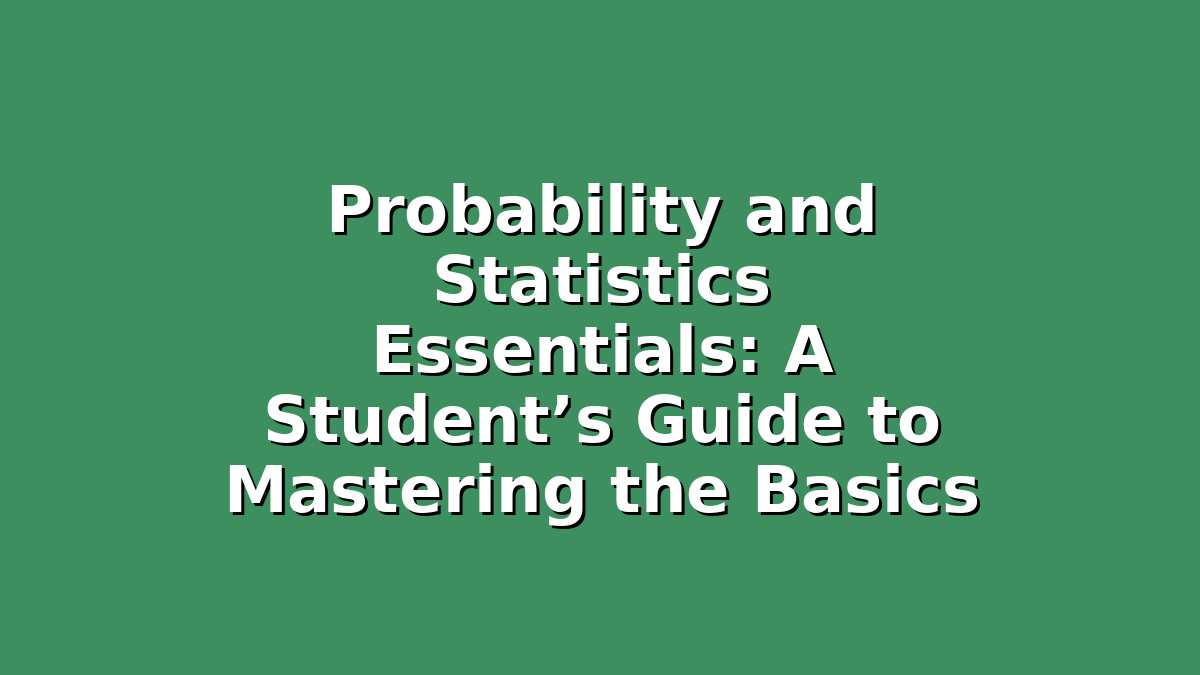Preparing for exams in subjects like mathematics or data science can be daunting, especially when it comes to topics like probability and statistics. These areas are fundamental not only in academics but also in many real-life applications such as business decisions, scientific experiments, and even everyday problem-solving. If you’re a student gearing up for exams or simply want to strengthen your understanding, this guide will walk you through the essentials of probability and statistics, while offering effective study tips to boost your confidence and performance.
Understanding the Basics: Why Probability and Statistics Matter
Before diving into study strategies, it’s crucial to grasp what probability and statistics really encompass. Probability is the branch of mathematics that measures the likelihood of an event happening. It helps us quantify uncertainty and make predictions based on known data or assumptions. Statistics, on the other hand, deals with collecting, analyzing, interpreting, and presenting data. It allows us to make informed decisions by extracting meaningful insights from raw information.
Together, probability and statistics form a powerful toolkit for analyzing patterns, testing hypotheses, and solving problems in a structured way. Whether your exam focuses on theoretical concepts or applied problems, a solid foundation is key to success.
Section 1: Master the Core Concepts with Clear Understanding
One of the biggest challenges students face is memorizing formulas without fully understanding the underlying concepts. To avoid this trap, start by focusing on the fundamental principles:
– Probability Basics: Learn what probability values represent (ranging from 0 to 1), and familiarize yourself with terms like sample space, events, independent and dependent events, and mutually exclusive events. Practice calculating simple probabilities by listing outcomes or using formulas.
– Types of Probability: Understand the difference between theoretical probability (based on known outcomes), experimental probability (based on observed results), and subjective probability (based on personal judgment).
– Descriptive Statistics: Get comfortable with measures of central tendency (mean, median, mode) and measures of dispersion (range, variance, standard deviation). These help summarize data sets effectively.
– Inferential Statistics: Grasp the concepts of populations vs. samples, sampling methods, and confidence intervals. Recognize how hypothesis testing works, including null and alternative hypotheses, significance levels, and p-values.
Study Tip: Use visual aids such as probability trees, Venn diagrams, and histograms to better understand relationships between events and data distributions. Drawing these out can demystify complex ideas and make them more intuitive.
Section 2: Practice Problem-Solving with Real Exam Questions
The best way to prepare for probability and statistics exams is to practice with a variety of problems. This builds familiarity with question formats and improves your problem-solving speed and accuracy.
– Start Simple: Begin with straightforward problems that reinforce basic calculations, like finding the probability of rolling a certain number on a die or calculating the mean of a small data set.
– Gradually Increase Difficulty: Move on to questions involving conditional probability, combinations and permutations, and interpretation of statistical graphs and charts.
– Work on Word Problems: Many exams include scenarios requiring translation of real-world situations into mathematical expressions. Practice breaking down these problems into manageable steps.
– Use Past Papers and Online Resources: Past exams are goldmines for understanding exam patterns and commonly tested topics. Platforms like Khan Academy, Brilliant, and other educational websites provide interactive exercises and detailed solutions.
Study Tip: Time yourself while solving problems to simulate exam conditions. Review mistakes carefully, and don’t hesitate to revisit theory if you get stuck. Repetition and correction are key to mastering challenging topics.
Section 3: Develop Effective Study Habits and Exam Strategies
Beyond content knowledge, how you study can significantly impact your exam performance. Here are some strategies tailored to probability and statistics:
– Create a Formula Sheet: Writing down important formulas and definitions helps reinforce memory. Organize them clearly with examples for quick reference.
– Form Study Groups: Explaining concepts to peers and tackling problems together can deepen understanding. Group discussions often reveal different perspectives and problem-solving methods.
– Use Technology Wisely: Statistical software like Excel, R, or even calculators with statistical functions can aid in verifying results and visualizing data. Familiarity with these tools may also be beneficial if your exam permits their use.
– Focus on Interpretation Skills: Many statistics questions require interpreting data rather than just calculating numbers. Practice explaining what a confidence interval means or how to conclude from a hypothesis test.
– Stay Consistent and Take Breaks: Regular, focused study sessions are more effective than cramming. Balance study with breaks to maintain concentration and reduce anxiety.
Study Tip: Before the exam, review summaries and quick notes, but avoid learning new topics last minute. Trust your preparation and go in with a positive mindset.
Conclusion: Confidence Comes with Preparation
Probability and statistics may seem challenging at first glance, but with the right approach, you can master these subjects and excel in your exams. Focus on understanding core concepts, practice regularly with real problems, and develop study habits that suit your learning style. Remember, every expert was once a beginner — persistence and curiosity will take you far.
Stay motivated, use the tools and tips shared here, and don’t hesitate to seek help from teachers or classmates when needed. Your efforts will pay off, giving you not just better grades, but valuable skills for the future.
Good luck with your studies!

Responses